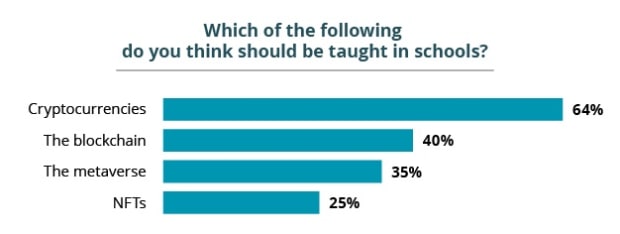Being a Bitcoiner is one part of the journey, but bitcoin adoption happens when we can teach others about the importance of hard, sound money.
This is an opinion editorial by Phil Snyder, professor, video director and editor.
While first developing my Bitcoin course at the University of Houston, I felt a little like Dr. Albert Schweitzer landing ashore at Equatorial Africa in 1913. I had my trusty black bag full of orange pills, but had no idea if any of the natives would swallow what I prescribed. Then there was that obligatory rabbit hole to dig first, so they would have some place to go for the requisite harrowing fall. As is the case in any missionary effort, the first imperative is to establish a beachhead by winning over the tribal chiefs. In my case those would be the Digital Media Program Coordinator and the chair of our department at the College of Technology.
But before sticking my neck out, I needed to see if any other Bitcoin missionaries had preceded me. I was astonished to discover that as of fall 2020, there wasn’t a single accredited course about Bitcoin in the entire university system — not even in Computer Engineering or the College of Business. The only higher education course I could find at the time was (now SEC Chairman) Gary Gensler’s 2018 offering at MIT, which has millions of views on YouTube. So, it’s not as if there isn’t a market for it. A recently released survey found that two-thirds of parents and college graduates who had an understanding and stake in cryptocurrencies believe that the subject should be required in schools. Frankly, as a non-tenure-track instructional associate professor whose job was teaching film, video and animation, I wasn’t keen to take on an additional load of this magnitude and risk, but finally complied with what my conscience insisted was my fiduciary duty.

I’ll skip the parts in this missionary metaphor about dodging poisonous blow darts, even though there were a few. After receiving permission to teach the course, we created a flier to be circulated among prospective students at the college. I was pictured holding one of those novelty representations of a “bitcoin,” offering it as an incentive for students to enroll. My boss sent it out to a few hundred students, stating that I would be giving each enrollee a bitcoin! You are correct if you assume he did not understand the basics. There were a few students who knew enough to reply that it had to be a joke, and I was happy to not get sued for false advertising. Soon after that, my boss was the first to receive my introductory lecture.
By the time our three-credit course was in session, El Salvador’s rollout of bitcoin as legal tender was in full swing. One of my students was from San Salvador, and his family back home were experiencing President Nayib Bukele’s bold initiative firsthand. My student solemnly expressed his and his family’s fears and misgivings about the top-down nature of its implementation. I repeatedly expressed my sincere hope to him that it would all work out to their great benefit, and that he would be able to take what he learned in the course and make good use of it at home as a newly minted Bitcoin evangelist.
As I write this, we are in the third week of the 2022 fall semester. During one lecture, while I was describing bitcoin’s resistance to confiscation and protection against inflation, one of my students chimed in that she was from Venezuela and that she and her family had personally experienced the utter devastation caused by unsound money printing policies of the unscrupulous dictator Nicolás Maduro. She agreed that small bitcoin miners found financial salvation from the disasters around them. I managed to maintain composure, but it was a struggle. The emotion in the classroom was palpable.
Stories like these are real-world anecdotal evidence of the dire need for the fantastically far-reaching solution that is Bitcoin. Americans sometimes chuckle about our “first-world” problems such as not having a wallet large enough to hold all our fiat, while citizens of developing nations face life-and-death circumstances that bitcoin can (and is) solving. Yet we are still such a long way from reaching a critical mass of conversion.
I don’t think of myself as being on the front lines of the war against fiat here in my cushy academic job, yet I do have hopes of making a genuine impact in the struggle. As part of our outreach efforts, we’ve been collaborating with the Texas Blockchain Council and Fort Bend Chamber of Commerce in hosting popular educational networking events, and we will soon be mining bitcoin as a research project with a state-of-the-art ASIC miner and support from Foundry Digital.
As a Bitcoiner, you may be experiencing similar feelings to mine a couple of years ago: my head exploding with anticipation at the world-disrupting potential of bitcoin, yet without any idea of how, beyond investing, to get involved in spreading the gospel. Well, the good news is you’re already on the way by educating yourself, which is the first step. You’ve seen the sights here in the rabbit hole — which get “curiouser and curiouser” — and while you feed your growing curiosity with the magical mushrooms of expanding knowledge, the opportunities will certainly appear at each providential nexus. Whether it be on the streets of San Salvador or in the checkout line at Costco, you are being trained by an omniscient, invisible intelligence who loves you and loves the people you are sent to orange pill.
“From everyone who has been given much, much will be required; and to whom they entrusted much, of him they will ask all the more.” (Jesus in Luke 12:48)
This is a guest post by Phil Snyder. Opinions expressed are entirely their own and do not necessarily reflect those of BTC Inc. or Bitcoin Magazine.












